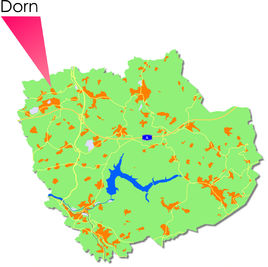Dorn (Reichshof)
|
mandrel
municipality Reichshof
Coordinates: 50 ° 59 ′ 23 ″ N , 7 ° 37 ′ 16 ″ E
|
|
|---|---|
| Height : | 305 m above sea level NHN |
| Residents : | 221 (December 31, 2008) |
| Postal code : | 51580 |
| Area code : | 02261 |
|
Location of Dorn in Reichshof
|
|
Dorn is one of 106 localities in the Reichshof community in the Oberbergischer Kreis in the North Rhine-Westphalian administrative district of Cologne in Germany .
Location and description
Dorn is located east of Dieringhausen , the closest centers are Gummersbach (10 km northwest), Cologne (54 km west) and Siegen (46 km southeast).
First mention
The place was mentioned for the first time in 1509, namely "Johentgen and Herman vom Dorn are witnesses in a border circuit."
Spelling of the first mention: Dorn
Dorn has a natural name. Zum Dorn (ma. Doorn) = settlement near thorn bushes.
history
In the parish of Eckenhagen there existed until the beginning of the 19th century, when the legal differences between knight, saddle and farm property were completely eliminated, 6 saddle goods, u. a. Alp. This comprised "10 Aggerhöfe", in addition to Dorn , Oberalpe and Niederalpe, Hunsheim, Berghausen, Ohlhagen, Fahrenberg, Seifen, Merkausen, Allinghausen, and Allenbach.
The documents of the Alper Bürger Club indicate that stately stone buildings rose around a well-fortified keep, where otherwise the villages were only characterized by low half-timbered houses. Both places (“In der Olpe” and “In der nider Olpe”) are referred to as “ a castle and Adelicher seß (seat)”.
The book "Eckenhagen and Denklingen in the Changing Times" shows that there was a Peter von Heydt, known as Hüngerkausen, who lived in Niederalpe around the middle of the 16th century. In 1560 he married a non-aristocratic woman, Gertrud from Ohlhagen. The marriage resulted in 5 children. He sat down shortly before his death a memorial by the 10 Agger courts the "house to the mandrel together with the garden behind it, alloyed to the glory of God before one Kapell and schoolhouse and also fifty Rthlr." Gave. The execution of the will took place on October 9, 1622 by the brother Johann. For more details see also: Church or School.
The "Eigen von Eckenhagen" reported in 1575 consisted of 2 church or parish villages, 83 hamlets and 18 individual farms. The latter have become hamlets over time, including Dorn, while others have disappeared.
Of all the pledged goods and land the treasure or the compulsory deduction from the tax was originally from the Bede distinguished or voluntary tax, levied. According to the waiter's bills from 1749, it was the task of the Honschaften in Eigen von Eckenhagen to collect the taxes in the 105 localities for the Windeck office. Hunsheim was one of 7 honors in the parish of Eckenhagen, also responsible for Dorn.
Mining
Mining started early on in the villages of Dorn, Fahrenberg and Pochwerk . On February 18, 1762, shift supervisor Klein and the like were enfeoffed with the lead mine “bei der Ober-Alpe”, which was still in operation in 1765.
leisure
Association
- MGV Concordia Dorn
Individual evidence
- ^ Klaus Pampus: First documentary naming of Oberbergischer places (= contributions to Oberbergischen history. Sonderbd. 1). Oberbergische Department 1924 eV of the Bergisches Geschichtsverein, Gummersbach 1998, ISBN 3-88265-206-3 .
literature
- Oswald Gerhard: Eckenhagen and Denklingen through the ages. A home history of the former Reichshof area of Eckenhagen (the current municipalities of Eckenhagen and Denklingen) as a contribution to the history of the Oberbergisches Land. Heimatverein eV, Eckenhagen 1953.

